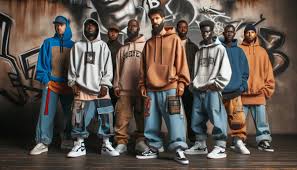Men’s fashion has undergone significant transformations over the centuries, reflecting changes in society, culture, and technology. From the tailored suits of the early 20th century to the casual and eclectic styles of today, men’s fashion has evolved to embrace diversity, self-expression, and practicality. This article explores the journey of men’s fashion, highlighting key trends, influences, and shifts that have defined each era.
Early 20th Century: The Age of Elegance
- Formal Wear and Tailoring: In the early 1900s, men’s fashion was characterized by formality and precision. Tailored suits, often with waistcoats and pocket watches, were the norm for the upper class. Morning suits and frock coats were common for daywear, while evening attire included tuxedos and tailcoats. This era emphasized craftsmanship and attention to detail, with bespoke tailoring being a mark of status.
- The Influence of War: World War I and World War II had a significant impact on men’s fashion. The need for practicality and uniformity during wartime led to simpler, more functional clothing. Military uniforms influenced civilian fashion, introducing elements like trench coats, bomber jackets, and khaki trousers. These practical and durable styles became staples in men’s wardrobes.
Mid-20th Century: The Rise of Casual Wear
- Post-War Fashion: The post-war period saw a shift towards more relaxed and casual styles. The economic boom and cultural changes of the 1950s brought about new fashion trends. Casual wear, including jeans, leather jackets, and t-shirts, gained popularity, influenced by Hollywood icons like James Dean and Marlon Brando. The rebellious and youthful look of the 1950s contrasted sharply with the formality of previous decades.
- The 1960s and 1970s: The 1960s and 1970s were decades of experimentation and cultural upheaval, reflected in men’s fashion. The Mod movement in the UK introduced sharp, tailored suits, skinny ties, and Chelsea boots. In contrast, the hippie movement embraced psychedelic prints, flared trousers, and bohemian styles. This era also saw the rise of sportswear and leisurewear, with brands like Adidas and Puma becoming household names.
Late 20th Century: Diversity and Innovation
- The 1980s Power Dressing: The 1980s were marked by a return to more formal and structured styles, known as “power dressing.” Influenced by the corporate culture and economic prosperity of the time, men embraced sharp, bold suits with wide lapels and padded shoulders. Designer labels like Armani and Versace became synonymous with luxury and success.
- The Grunge Movement: The early 1990s saw a stark contrast with the previous decade’s opulence, as the grunge movement took hold. Originating from the music scene in Seattle, grunge fashion embraced a laid-back, anti-establishment aesthetic. Flannel shirts, ripped jeans, and combat boots defined this era, popularized by bands like Nirvana and Pearl Jam.
- The Late 1990s and Early 2000s: The late 1990s and early 2000s were characterized by a mix of styles, from the minimalist approach of brands like Calvin Klein to the flashy, logo-heavy designs of streetwear brands like FUBU and Sean John. Casual wear continued to dominate, with denim, cargo pants, and graphic tees becoming everyday staples.
Contemporary Men’s Fashion: Embracing Individuality
- Streetwear and Athleisure: The 2010s saw the rise of streetwear and athleisure as dominant forces in men’s fashion. Brands like Supreme, Off-White, and Nike redefined casual wear, blending comfort with style. Hoodies, sneakers, joggers, and graphic tees became essential items, with streetwear often blurring the lines between high fashion and everyday wear.
- Sustainable and Ethical Fashion: In recent years, there has been a growing emphasis on sustainability and ethical practices in men’s fashion. Brands are increasingly focusing on eco-friendly materials, fair labor practices, and transparency in their supply chains. This shift reflects a broader awareness and concern for environmental and social issues among consumers.
- Gender Fluidity and Breaking Norms: Contemporary men’s fashion is characterized by a breaking down of traditional gender norms. Designers and brands are embracing gender-fluid and androgynous styles, challenging the conventional boundaries of men’s and women’s fashion. This trend is evident in the increasing popularity of skirts, makeup, and jewelry for men, as well as the rise of unisex collections.
- Digital Influence and E-Commerce: The digital age has profoundly impacted men’s fashion, with social media and e-commerce driving trends and consumer behavior. Platforms like Instagram and TikTok have become essential for fashion inspiration and discovery, while online shopping offers convenience and accessibility. Influencers and digital-first brands play a significant role in shaping modern men’s fashion.
The Future of Men’s Fashion
- Technological Innovations: Technology will continue to influence men’s fashion, from smart fabrics and wearable tech to virtual fashion and augmented reality shopping experiences. Innovations like 3D printing and customization will enable more personalized and sustainable fashion solutions.
- Inclusivity and Representation: The future of men’s fashion will prioritize inclusivity and representation, reflecting the diverse identities and experiences of consumers. Brands will need to embrace a wider range of body types, skin tones, and cultural backgrounds to stay relevant and resonate with their audience.
- Sustainable Practices: Sustainability will remain a crucial focus, with ongoing efforts to reduce the environmental impact of fashion production and consumption. Circular fashion models, eco-friendly materials, and ethical practices will become standard expectations for consumers.
- Hybrid Styles and Adaptability: As lifestyles continue to evolve, men’s fashion will likely see more hybrid styles that combine elements of formal, casual, and athletic wear. Adaptability and versatility will be key, with clothing designed to seamlessly transition between different settings and activities.
Conclusion
Men’s fashion has evolved significantly over the past century, reflecting broader societal changes and technological advancements. From the formal elegance of the early 20th century to the casual and diverse styles of today, each era has brought its unique influences and trends. As the fashion industry continues to innovate and adapt, men’s fashion will undoubtedly evolve further, embracing sustainability, inclusivity, and technological advancements. The future of men’s fashion promises to be exciting and dynamic, offering endless possibilities for self-expression and creativity.
